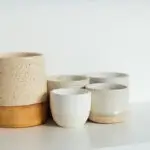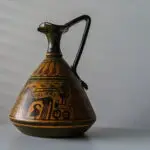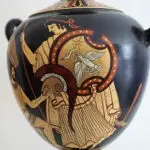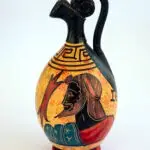Mediterranean pottery has been a source of fascination for collectors and enthusiasts for centuries. The region’s rich history and diverse cultures have contributed to a wide variety of pottery styles and techniques, each with its unique characteristics and appeal. Collecting and preserving Mediterranean pottery is not only a way to appreciate its beauty but also to preserve its cultural and historical significance for future generations.
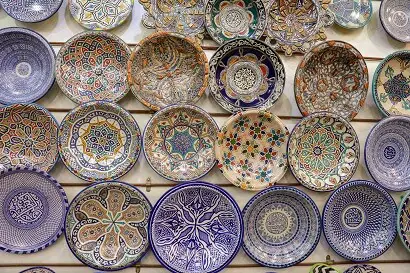
Understanding the value of Mediterranean ceramics or pots is an essential first step in building a collection. Authentic Mediterranean pottery can be identified by its unique shapes, designs, and materials. Building a personal collection of Mediterranean pottery requires patience, knowledge, and a discerning eye. Collectors must be aware of the many fakes and reproductions on the market and learn to identify the tell-tale signs of inauthentic pieces.
Key Takeaways
- Collecting and preserving Mediterranean pottery is a way to appreciate its cultural and historical significance.
- Authenticity is crucial when building a collection of Mediterranean pottery.
- Proper handling, preservation, and restoration techniques are vital to ensure the longevity of a Mediterranean pottery collection.
Understanding the Value of Mediterranean Pottery
Mediterranean pottery has been a valuable commodity for centuries, both for its cultural significance and its aesthetic appeal. Understanding the value of Mediterranean pottery requires knowledge of its history, the different types of pottery, and the techniques used to create them.
In ancient times, pottery was an important part of daily life, used for cooking, storage, transportation, and export of goods. As such, pottery, including amphoras, was produced in large quantities, with both fine wares and coarse wares being made. Fine wares, including jugs, were highly decorated and often used for special occasions, while coarse wares were more utilitarian in nature. Corinth was particularly renowned for its fine pottery craftsmanship.
Ceramics was the primary material used in the production of the Mediterranean and ancient Greek pottery, and different types of pottery were created using varying techniques. Glazed ceramics were created by adding a layer of glass to the surface of the ceramic, while slip was a liquid clay mixture that was applied to the surface of the pottery before it was fired.
Earthenware was a type of pottery that was fired at a low temperature and was often used for everyday items. Porcelain was a type of pottery that was fired at high temperatures and was known for its delicate appearance.
Vase paintings were a popular way to decorate ancient Greece pottery, with scenes of animals, people, and mythical creatures often depicted. Faience was another popular type of pottery, known for its bright colors and intricate designs.
The value of Mediterranean pottery is not only in its aesthetic appeal but also in its cultural significance. Pottery can provide insight into the daily life, beliefs, and traditions of the people who created it.
For example, pottery found in ancient tombs in Athens can provide information about burial practices and beliefs about the afterlife for the ancient Greeks. The archaeological findings from antiquity and the motif of pottery shed light on ancient funerary customs.
In conclusion, understanding the value of Mediterranean pottery requires knowledge of its history, the different types of pottery, and the techniques used to create them. The cultural significance of pottery also adds to its value, providing insight into the daily life and traditions of the people who created it.
Identifying Authentic Mediterranean Pottery
Mediterranean pottery is known for its unique designs and durability. Collectors and enthusiasts alike are drawn to the rich history and cultural significance of these artifacts. However, with the rise of counterfeit pottery, it is important to know how to identify authentic Mediterranean pottery.
Materials Used
Authentic Mediterranean pottery is typically made from locally sourced materials such as clay, sand, and water. In some cases, copper and lead may be added to the clay to enhance its durability. Counterfeit pottery, on the other hand, may use cheaper materials or substitute them entirely with synthetic alternatives.
Design and Decoration
Mediterranean pottery is known for its intricate designs and vibrant colors. Authentic pottery may feature enamel or painted decoration, which is often applied by hand. Counterfeit pottery may use mass-production techniques, resulting in uniform designs and patterns.
Restoration and Fragments
Authentic Mediterranean pottery may show signs of wear and tear due to its age and use. However, restoration and repair work should be done with care and precision to maintain the integrity of the artifact. Counterfeit pottery may use adhesives or other materials to mask damage or reconstruct fragments, resulting in an inauthentic appearance.
X-Ray Analysis
X-ray analysis is a valuable tool in identifying authentic ancient Mediterranean pottery. It can reveal the structure and composition of the artifact, as well as any hidden repairs or alterations. X-ray analysis can also detect the presence of lead or other harmful materials, which may be used in counterfeit pottery.
In conclusion, identifying authentic Mediterranean pottery requires a keen eye for detail and a thorough understanding of the materials and techniques used in its creation. By carefully examining the design, materials, and restoration work, collectors and enthusiasts can ensure that they are acquiring a genuine piece of history.
Building a Personal Collection of Mediterranean Pottery
Building a personal collection of Mediterranean pottery can be a rewarding hobby for those interested in history, art, and culture. However, it requires careful planning and execution to ensure the collection is preserved and stored correctly.
The first step in building a personal collection of Mediterranean pottery is to determine the purpose of the collection. Is it for display or ceremonial use? Will it be used for research or educational purposes? Once the purpose is established, the collector can begin to focus on the type of pottery they want to collect.
The collector should research the different types of Mediterranean pottery available, including the regions where they were produced. For example, Provence in southern France is known for its distinctive pottery, while Athens in Greece is famous for its black-figure and red-figure pottery.
Once the collector has decided on the type of pottery they want to collect, they should begin to search for pieces to add to their collection. This can be done through antique shops, online marketplaces, and auctions.
When purchasing pottery, it is important to ensure that the pieces are authentic and in good condition. The collector should also consider the storage and display of the pottery.
Proper storage is essential to prevent damage from moisture, temperature changes, and other environmental factors.
The collector should invest in proper storage containers, such as acid-free boxes or cabinets, and avoid displaying the pottery in direct sunlight or areas with high humidity. They should also handle the pottery carefully, using gloves and avoiding harsh cleaning agents.
In conclusion, building a personal collection of Mediterranean pottery can be a fascinating and rewarding endeavor. It requires careful planning, research, and storage to ensure the collection is preserved for future generations to enjoy.
How to Display and Showcase a Mediterranean Pottery Collection
Displaying and showcasing a Mediterranean pottery collection can be an exciting and rewarding experience. Whether you are a collector or a museum curator, there are several things to keep in mind when presenting these unique artifacts to the public.
First, it is important to consider the context in which the pottery was created. Understanding the historical and cultural significance of the pieces can help to provide a deeper appreciation for their beauty and craftsmanship. Providing information about the time period, location, and cultural influences can be helpful for visitors to understand the context of the pottery.
Next, it is important to select an appropriate exhibition space that can showcase the pottery effectively. Choosing a space with ample natural light and neutral-colored walls can help to highlight the colors and textures of the pottery. Additionally, it can be helpful to use display cases or stands to elevate the pottery and provide a clear view for visitors.
When designing the layout of the exhibition, it can be helpful to group the pottery by time period, location, or style. This can help visitors to understand the evolution of Mediterranean pottery over time and appreciate the unique characteristics of each region.
Labeling and signage are also important considerations when displaying a pottery collection. Providing clear and concise information about each piece, including its origin, age, and significance, can help visitors to understand and appreciate the pottery. Additionally, including interactive elements, such as touchscreens or audio guides, can enhance the visitor experience and provide additional context for the pottery.
Finally, it is important to consider the preservation and conservation of the pottery. Proper storage and handling techniques can help to protect the pottery from damage and ensure its longevity. Additionally, regular cleaning and maintenance can help to preserve the beauty and integrity of the pottery for future generations to enjoy.
Overall, displaying and showcasing a Mediterranean pottery collection can be a rewarding experience that provides visitors with a deeper understanding and appreciation for these unique artifacts. By considering the context, exhibition space, layout, labeling, and preservation, you can create a memorable and educational experience for visitors.
Handling and Preservation of Mediterranean Pottery
When it comes to handling and preserving Mediterranean pottery, it is important to take certain precautions to ensure that the artifacts remain intact and in good condition. This section will cover some basic guidelines for handling and preserving Mediterranean pottery.
Handling
When handling Mediterranean pottery, it is important to take care not to damage the artifacts. Here are some tips for handling the pottery:
- Always handle the pottery with clean hands to avoid transferring oils and dirt to the surface of the pottery.
- Use gloves when handling fragile or valuable pieces to avoid leaving fingerprints on the surface of the pottery.
- When moving the pottery, use both hands to support the piece and avoid putting pressure on any weak points or fragile areas.
- Avoid dragging the pottery across surfaces as this can cause scratches and other damage.
Preservation
Preserving Mediterranean pottery is important to ensure that the artifacts remain intact and in good condition for future generations to enjoy. Here are some tips for preserving the pottery:
- Store the pottery in a cool, dry place to avoid exposure to moisture and humidity which can cause damage to the pottery.
- Avoid storing the pottery in direct sunlight or near sources of heat as this can cause the pottery to fade or become brittle.
- Use acid-free tissue paper or bubble wrap to wrap the pottery for storage to avoid scratching or chipping the surface of the pottery.
- When transporting the pottery, use padded containers to avoid damage during transit.
Restoration
If Mediterranean pottery has been damaged, restoration may be necessary to repair the artifact. Restoration should only be done by a professional conservator to ensure that the restoration is done correctly and does not cause further damage to the artifact.
Fragments
Fragments of Mediterranean pottery can be valuable in reconstructing the history of the artifact. When handling fragments, it is important to label each fragment with its location and orientation to ensure that the fragments can be accurately reconstructed.
Gypsum
Gypsum is a common material used in the restoration of Mediterranean pottery. Gypsum is used to create molds of the pottery which can be used to create replicas or to repair damaged areas of the pottery. When using gypsum, it is important to follow the manufacturer’s instructions to ensure that the gypsum is mixed correctly and does not cause damage to the pottery.
Overall, handling and preserving Mediterranean pottery requires care and attention to ensure that the artifacts remain intact and in good condition. By following these guidelines, collectors, and enthusiasts can enjoy these beautiful artifacts for years to come.
Restoration and Conservation of Mediterranean Pottery
Restoration and conservation of Mediterranean pottery, including amphoras, is essential to preserve the cultural heritage of the region. Pottery fragments are often found in archaeological sites and need to be restored to their original form to understand their historical significance. Restoration of pottery involves piecing together fragments, filling gaps, and reconstructing missing parts.
Gypsum is commonly used in the restoration process as it is a versatile material that can be molded to fit the shape of the pottery. The use of gypsum in restoration is a delicate process as it can damage fragile pottery if not handled correctly.
Conservation of pottery involves preventing further deterioration of the pottery. The conservation process includes cleaning, stabilizing, and protecting the pottery from environmental factors such as humidity, light, and temperature.
The restoration and conservation of Mediterranean pottery require skilled professionals who have extensive knowledge of the materials and techniques used in the process. The professionals must also understand the historical significance of the pottery to ensure that the restoration process does not alter or damage the original form of the pottery.
In some cases, restoration may not be possible due to the extent of the damage or the lack of fragments. In such cases, conservation is vital to preserve what remains of the pottery. Conservation techniques such as documentation, monitoring, and storage ensure that the pottery is protected and can be studied by future generations.
Overall, the restoration and conservation of Mediterranean pottery play a crucial role in preserving the cultural heritage of the region. It allows us to understand the historical significance of the pottery and the people who created it.
Research and Documentation for Each Piece in the Collection
When collecting and preserving Mediterranean pottery, it is crucial to conduct thorough research and document each piece in the collection. This documentation includes information about the potter, the production process, and the historical context of the piece.
To start, researchers should gather as much information as possible about the potter and painter who created the piece. This includes their name, birthplace, and any other relevant biographical information. Additionally, researchers should investigate the production process used to create the piece, including the type of clay used, the firing technique, and any decorative elements added to the piece.
Furthermore, historical context is essential when documenting Mediterranean pottery. Researchers should consider the time period in which the piece was created and any significant events or cultural influences that may have impacted the production process. This information can help provide a more comprehensive understanding of the piece and its significance.
Once all relevant information has been gathered, it is important to document it in a clear and organized manner. This can be achieved through the use of tables, bullet points, and bold text to highlight important details. Digital documentation is also recommended, as it allows for easy sharing and access to the information.
Overall, thorough research and documentation are essential when collecting and preserving Mediterranean pottery. By taking the time to gather and organize information about each piece, researchers can ensure that the historical significance of the pottery is preserved for future generations.
Sharing and Contributing Knowledge of a Mediterranean Pottery Collection
Sharing knowledge of a Mediterranean pottery collection, including the techniques and styles used by skilled painters, is essential to preserve the history and culture of the region. It is an opportunity to learn from the past and appreciate the craftsmanship of ancient civilizations. When sharing a pottery collection, it is important to provide accurate information about the origin, age, and function of each piece.
One way to share knowledge of a Mediterranean pottery collection is by hosting exhibitions. Exhibitions provide an opportunity to showcase the collection and educate the public about the history and culture of the region. It is also a chance to collaborate with other institutions and experts in the field to gain new insights and perspectives.
Another way to share knowledge is by contributing to academic research. Researchers use pottery to understand the social, economic, and political structures of ancient civilizations. By sharing information about the collection with researchers, it can contribute to a greater understanding of the past.
When sharing knowledge of a Mediterranean pottery collection, it is important to document the collection thoroughly. Documentation should include photographs, descriptions, and any other relevant information. This will ensure that the collection is preserved for future generations and can be used for academic research.
In addition to sharing knowledge, it is also important to contribute to the preservation of Mediterranean pottery. This can be done by supporting conservation efforts and donating to institutions that specialize in the preservation of ancient artifacts. By contributing to the preservation of Mediterranean pottery, it ensures that future generations can learn from the past and appreciate the beauty and craftsmanship of ancient civilizations.
- The Top Restaurants Specializing in Truffle Dishes - August 10, 2023
- Truffle Panna Cotta: A Decadent Dessert Recipe for Truffle Lovers - August 7, 2023
- Truffle Scrambled Eggs: A Luxurious Breakfast Delight - August 7, 2023

